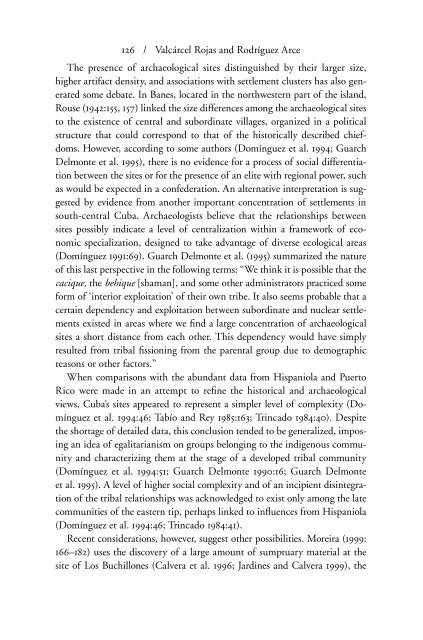Dialogues in Cuban Archaeology
by L. Antonio Curet, Shannon Lee Dawdy, and Gabino La Rosa Corzo
by L. Antonio Curet, Shannon Lee Dawdy, and Gabino La Rosa Corzo
Create successful ePaper yourself
Turn your PDF publications into a flip-book with our unique Google optimized e-Paper software.
126 / Valcárcel Rojas and Rodríguez Arce<br />
The presence of archaeological sites dist<strong>in</strong>guished by their larger size,<br />
higher artifact density, and associations with settlement clusters has also generated<br />
some debate. In Banes, located <strong>in</strong> the northwestern part of the island,<br />
Rouse (1942:155, 157) l<strong>in</strong>ked the size differences among the archaeological sites<br />
to the existence of central and subord<strong>in</strong>ate villages, organized <strong>in</strong> a political<br />
structure that could correspond to that of the historically described chiefdoms.<br />
However, accord<strong>in</strong>g to some authors (Domínguez et al. 1994; Guarch<br />
Delmonte et al. 1995), there is no evidence for a process of social differentiation<br />
between the sites or for the presence of an elite with regional power, such<br />
as would be expected <strong>in</strong> a confederation. An alternative <strong>in</strong>terpretation is suggested<br />
by evidence from another important concentration of settlements <strong>in</strong><br />
south-central Cuba. Archaeologists believe that the relationships between<br />
sites possibly <strong>in</strong>dicate a level of centralization with<strong>in</strong> a framework of economic<br />
specialization, designed to take advantage of diverse ecological areas<br />
(Domínguez 1991:69). Guarch Delmonte et al. (1995) summarized the nature<br />
of this last perspective <strong>in</strong> the follow<strong>in</strong>g terms: “We th<strong>in</strong>k it is possible that the<br />
cacique, the behique [shaman], and some other adm<strong>in</strong>istrators practiced some<br />
form of ‘<strong>in</strong>terior exploitation’ of their own tribe. It also seems probable that a<br />
certa<strong>in</strong> dependency and exploitation between subord<strong>in</strong>ate and nuclear settlements<br />
existed <strong>in</strong> areas where we ¤nd a large concentration of archaeological<br />
sites a short distance from each other. This dependency would have simply<br />
resulted from tribal ¤ssion<strong>in</strong>g from the parental group due to demographic<br />
reasons or other factors.”<br />
When comparisons with the abundant data from Hispaniola and Puerto<br />
Rico were made <strong>in</strong> an attempt to re¤ne the historical and archaeological<br />
views, Cuba’s sites appeared to represent a simpler level of complexity (Domínguez<br />
et al. 1994:46; Tabío and Rey 1985:163; Tr<strong>in</strong>cado 1984:40). Despite<br />
the shortage of detailed data, this conclusion tended to be generalized, impos<strong>in</strong>g<br />
an idea of egalitarianism on groups belong<strong>in</strong>g to the <strong>in</strong>digenous community<br />
and characteriz<strong>in</strong>g them at the stage of a developed tribal community<br />
(Domínguez et al. 1994:51; Guarch Delmonte 1990:16; Guarch Delmonte<br />
et al. 1995). A level of higher social complexity and of an <strong>in</strong>cipient dis<strong>in</strong>tegration<br />
of the tribal relationships was acknowledged to exist only among the late<br />
communities of the eastern tip, perhaps l<strong>in</strong>ked to <strong>in</strong>®uences from Hispaniola<br />
(Domínguez et al. 1994:46; Tr<strong>in</strong>cado 1984:41).<br />
Recent considerations, however, suggest other possibilities. Moreira (1999:<br />
166–182) uses the discovery of a large amount of sumptuary material at the<br />
site of Los Buchillones (Calvera et al. 1996; Jard<strong>in</strong>es and Calvera 1999), the


















